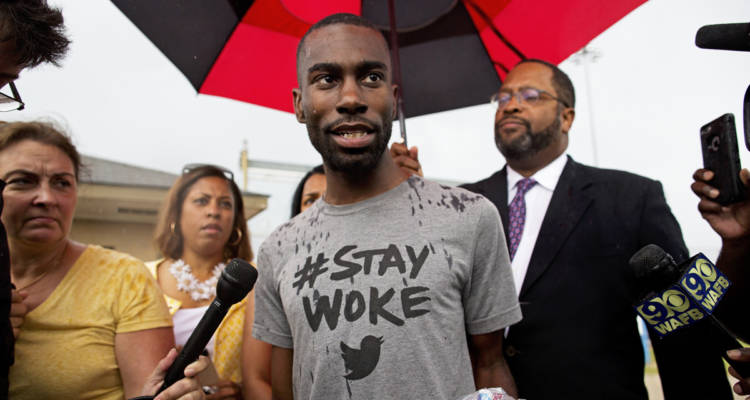

Louisiana, Minnesota, Texas and three new horrors. They brought an avalanche of poignant and pointed coverage. The page 1 Sunday headlines included “After deadly week, unease rises on both sides of the badge.” and “Time to End ‘Silent War.'” But what happens now?
When it comes to guns, if the past is prologue, nothing will happen. Further, University of Chicago Crime Lab researchers tell me that there’s not trustworthy data on fatal shootings by police, given underreporting by U.S. law enforcement agencies that’s pretty severe.
Some analyses suggest a decline, others suggest the opposite. Regardless, the press will lose interest and legislators won’t feel much pressure without a really significant push from constituents. The gun control lobby will prove scattered and close to impotent (sorry, Mike Bloomberg). The role of press coverage has been well-documented by Danny Hayes of George Washington University, but he cautioned me against finding a commonality between massacres and what just played out.
“I think the events of the last week are quite different than the mass shootings that you and I have talked about before,” he said. “For one thing, the Baton Rouge and Minnesota killings are not at all like those previous incidents — they involve police officers killing citizens, not mass shootings.”
He notes that the Dallas shooting was also distinct in that authorities say it was motivated by revenge against police. As a result, the debate has been focused on racial justice and race relations, not gun control.
What does it tell us beyond the ramifications of such events being broadcast live on Facebook, or the ambiguous matter of Facebook’s role as a gatekeeper for news?
Colin Greer, an educator-playwright who is president of the New York-based New World Foundation, a civil rights organization, believes that one inference many may draw mistakenly is about “Black violence. It reinforces the idea that ‘these people had it coming to them.’ The focus on the black power salute of one photo shot of a single person. The insistence on snipers in Dallas even after it was clear there was only one, the search of police records (even traffic stops) of black men shot, all replay the violent culture of black poverty theme that has long been with us and is quite quite wrong. We have been socialized to fear young Black men, cops included.” He discerns such a drumbeat since the Trayvon Martin case. But he also finds the theme of a return to 1960s-like societal convulsions to be bogus. “There’s no resemblance,” he said late Sunday, in part because there’s no unifying objective underpinning it all.
He asks that we also take at look at the Brexit vote and Trump’s popularity. “It’s about undervaluing working people, Black and White,” he said. “And police are working people who are afraid of having developed an image of young Black people as violent. There’s no social movement here with a clear agenda. Only anger and guilt.”
But he, for one, does think there’s a hidden story being largely missed: the weapons industry. “It’s armed the streets up the gazoo, with the NRA the front for that. Arming citizens (and law enforcement) in an enormously profitable way. It’s no surprise that Louisiana is an open carry state, where this young man had a gun.”
Gretchen Carlson vs. Roger Ailes
Six women spoke to New York magazine, alleging harassment from Ailes. Two went on the record, the others requested they not be precisely identified. Some of the allegations go back decades, to Ailes’ days as a talk show producer. (New York)
Carlson is clearly being proactive. “In fact, in the early days of this event, which has transfixed close watchers of Ailes’ media empire and fans of the network, it is Fox News that looks like it has been hit. And this highly successful rollout of Carlson’s case was the work of professionals who, while they may not be boldfaced names you know from other celebrity lawsuits (think Gloria Allred), are certainly not ambulance-chasers. (Politico)
An editor’s very personal critique
Reviewing Peter Kramer’s “ORDINARILY WELL: The Case for Antidepressants,” Atlantic Editor Scott Stossel writes, “But as the author of a book on mental illness, I’ve read deeply in the scientific and historical literature, including all the books attacking Big Pharma. Perhaps more relevantly, I have copious experience with taking antidepressants. Can I say with 100 percent certitude that they’ve worked? No. In fact, some of those drugs definitively did not work for me, and sometimes made my anxiety worse, or created inconvenient and, at times, intolerable side effects.” (The New York Times)
Brexit victim: Serena Williams
Pass the hat: “Williams beat Angelique Kerber 7-5, 6-3 in Saturday’s Wimbledon final, her 22nd major title, tied with Steffi Graf for most in the Open Era. The winner’s prize is worth $2.59 million when converted to U.S. dollars, about $380,000 less than it was worth a few days before the tournament, on the eve of the U.K.’s vote to leave the European Union.” (Bloomberg) Ditto Andy Murray, the men’s champ.
Bill Cunningham Corner (at least for a bit)
The late New York Times photographer-about-town Bill Cunningham will at least temporarily have the intersection of 57th Street and Fifth Avenue (his favorite photo spot for catching fashion trends) named after him (“Bill Cunningham Corner”). The mayor’s office says making it permanent would require jumping many legal hurdles. (New York) Party poopers! In Chicago, clout wins out in far more efficient, less needlessly democratic ways. It’s how I live a couple of blocks from Bob Fosse Way, named after the choreography giant who grew up and went to elementary and high schools in the hood.
Is Hillary the Queen of FOIA evaders?
As noted here last week upon the 50th anniversary of the Freedom of Information Act, President Lyndon Johnson signed it but hated it. Now, writes former Wall Street Journal Publisher L. Gordon Crovitz, “The question now is how FOIA survives the precedent Hillary Clinton set with her basement server intended to keep her emails hidden from public view. …No public official since LBJ has gone as far as Hillary Clinton to evade public-disclosure laws.” (The Wall Street Journal)
Messi’s mess defended
F.C. Barcelona, the employer of soccer superstar Lionel Messi, went overboard in backing him in the wake of his conviction for tax evasion. Its website announced, “FC Barcelona has set up a campaign in support of Leo Messi following the sentence issued this week against the Argentinian and his father.” It indicated that “by making it clear that #WeAreAllMessi, we want Leo to know that he is not alone.” That’s right, not alone in his tax evasion. (PFA)
Disclosures from a dad
Kathy Bergen, a business reporter at the Chicago Tribune, had never really heard Hal Bergen, her father and an 89-year-old retired public relations executive, discuss his serving as a 19-year-old Army sound technician during the Nuremberg trials, the first international prosecution of genocide. In that role, he “asked notorious defendants such as Hermann Goering and Rudolf Hess if their audio headsets were operating properly.” But it was an experience that really didn’t come to light for her until a few weeks ago. (Chicago Tribune) But there were other moments far from the banal — as when prosecutors showed films to counter defense testimony. “‘The ones that got to me the most,’ my dad said, ‘were films where (the Nazis) were throwing corpses of Jews into open graves like cordwood.'”
A reporter steps back and…
Darryl Fears covered race and demographics for The Washington Post for eight years, “crisscrossing the country to write about segregated schools, crowded prisons and huge immigration marches, and I left the beat thinking that President Obama’s election in 2008 might bring at least a margin of the hope and change he embraced. But America hasn’t changed. You could argue persuasively that the racial climate has become worse. (The Washington Post)
Larry Bird on Kevin Durant
Sports journalism has been in overdrive of late on the frenetic market for pro basketball players, both stars and mediocrities, as a result of giant sums the teams must start paying out as a result of their riches and a union contract. Listeners to Sirius XM NBA Radio even heard one long-retired legend, Larry Bird, opine on superstar Kevin Durant’s move to the very talented Golden State Warriors. “I know back in the day, I couldn’t imagine going to the Lakers and playing with Magic Johnson. I’d rather try to beat him. I could never imagine myself going and joining another team with great players, because I had great players and I was in a great situation.” (ESPN)
Reprising a brilliant cartoon
On Sunday, The Dallas Morning News offered an editorial, “This City, Our City,” which included an illustration of an eye with a tear and the city skyline inside and concluded, “There will be time later for anger and for justice — anger whose purpose is served in justice. But for now we need to learn to understand each other, to really hear one another, to learn from each other. (Poynter) Perhaps it was a mere coincidence, but the illustration might have prompted a few old-timers to recall the classic Bill Mauldin illustration in The Chicago Sun-Times, after the 1963 assassination of President Kennedy in Dallas. It shows a weeping Abe Lincoln, head in hands, at the Lincoln Memorial. (Chicago Sun-Times) Mauldin won the Pulitzer Prize twice and was a giant who died in 2003. (The New York Times)
Sydney Schanberg R.I.P
Have you ever seen “The Killing Fields?” It’s a great flick inspired by the nervy reporting of Sydney Schanberg, a New York Times correspondent who won a Pulitzer Prize for covering Cambodia’s fall to the Khmer Rouge in 1975, including the saga of “a Cambodian colleague’s survival during the genocide of millions.” Schanberg fled but was reunited two years later with photographer Dith Pran. (The New York Times) Schanberg, who started as a copy boy at the paper and rose through the reporting ranks, died at age 82 in Poughkeepsie, New York. “A restive, intense, Harvard-educated newspaperman with bulldog tenacity, Mr. Schanberg was a nearly ideal foreign correspondent: a risk-taking adventurer who distrusted officials, relied on himself in a war zone and wrote vividly of political and military tyrants and of the suffering and death of their victims with the passion of an eyewitness to history.”
His book, “The Death and Life of Dith Pran,” inspired the 1984 movie in which he was played brilliantly by Sam Waterston. He became a Times columnist but quit amid disagreement over a big local highway project whose defeat was seen by some as “one of the great citizen victories of our time.” (Village Voice) He joined Newsday as a columnist. “He was a major force in journalism, in the newspaper business,” Les Payne, a former Newsday columnist and editor said. “I think that courage is an easy word to throw around, but it applies to him and what he did in Southeast Asia…I found him an impeccable reporter and a painstakingly great writer.” (Newsday) Jane Freiman, a former Newsday restaurant critic, said he was hilariously funny, a great dad and a great granddad. But go rent the movie. It’s a small window onto a great, admirable career.
[Source:- Poynter]





